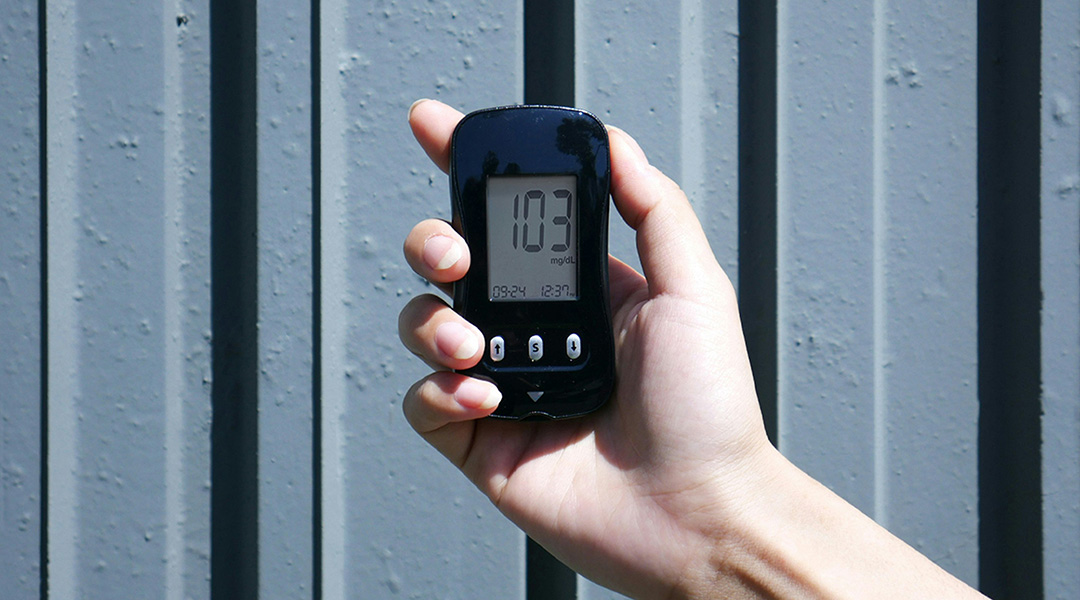A simple, wearable patch that monitors the user’s sweat could help identify early signs of low blood sugar in someone with diabetes.
Low blood sugar — or hypoglycemia — can occur suddenly and without warning; severely low blood sugar levels can even lead to seizures, coma, or death. Taking too much insulin or skipping meals can make blood sugar levels drop, and low blood sugar doesn’t always cause symptoms.
“In rare cases, nocturnal hypoglycemic incidents can lead to unexpected and sudden death in young people with type 1 diabetes, with reported rates up to 10 times higher than those without diabetes,” wrote the authors of a new study recently published in Advanced Materials Technologies.
The researchers say their technology can help identify low blood sugar before it becomes dangerous.
A better way to check for low blood sugar
People with type 1 diabetes who use a finger-stick glucose monitor need to check their blood sugar at least four times a day. Continuous glucose monitors make keeping track of blood sugar levels a little simpler; with this method, a sensor placed under the skin monitors blood sugar continuously.
Both of these methods are imperfect. Finger sticks are uncomfortable and susceptible to user error. Continuous glucose monitors need to be recalibrated frequently, which also requires a finger stick, and they create a break in the skin that could make the user vulnerable to infection.
The wearable sensor described in the paper does not use needles or finger sticks. “We propose an autonomous, wearable and flexible patch with wireless energy-harvesting capabilities that can detect real-time low-concentration glucose in sweat and monitor the body temperature, along with the [heart rate variability] as early indicators of hypoglycemia,” the researchers wrote.
The device is just 4 cm in diameter and is attached to the wrist with a medical skin adhesive. The adhesive is strong enough to remain in place even during heavy exercise. Sweat is directed through a tiny, “microfluidic” channel into a collection chamber; glucose levels in the collected sweat are measured before it flows out again. The device also monitors heart rate variability and body temperature, and uses these measurements to identify early signs of hypoglycemia.
In human tests, subjects were monitored from 9am to 9pm. During this time, the subjects engaged in routine daily activities. “Although the sweating rate is much lower during daily activities such as working, eating, or resting compared to exercise conditions, even this rate of perspiration might be enough for continuous health monitoring,” the authors wrote.
“Similar to some studies where small dimensions of the microfluidic layer enabled sweat sensing with small volumes of collected sweat, we also selected the dimensions of the microfluidic system in a way to minimize the amount of required liquid for sweat sensing,” they continued.
The researchers compared their measurements to the measurements of a traditional finger-stick blood glucose monitor and found that the two measurements followed the same trend. However, the researchers also noted a lag time of 30 to 60 minutes between the blood glucose measurements and those of the sweat sensor.
Larry Cheng, associate professor of engineering at Penn State University, who was not involved in the study, said the glucose sensor used in the study had good sensitivity and detection limit, but as he also noted, “the correlation between sweat and blood glucose concentrations is not very strong in the long term, which can present challenges for practical use.”
Self-charging for longer battery life
To address the problem of battery life, the researchers included a built-in energy harvesting system that can draw power from nearby wireless networks and use it to extend the life of the device’s tiny lithium-ion polymer battery. The harvester is necessary to enable long-term monitoring.
“Using it without a harvester circuit led to ≈3.5 hours of continuous measurements, while the harvester circuit increased the battery’s lifetime by almost 250%,” the researchers wrote. When not in use, they said, the battery will fully recharge.
The technology does have a few apparent drawbacks: In order for the energy harvester to work, the device needs to access a high-powered Wi-Fi router. This could limit its practical use, since the wearer would experience shorter battery life when not in proximity to the right kind of power source.
Though the researchers discuss nocturnal hypoglycemic incidents early on in the paper, their study only tested the device during the day, leaving an open question as to whether it could help detect hypoglycemic events while the user is asleep. And since the device is specifically designed to look for evidence of low blood sugar, it could not replace traditional glucose monitoring devices, which can also detect high blood sugar.
Even considering these limitations, the device has promise as an adjunct to existing glucose monitoring devices, especially since traditional devices don’t also monitor heart rate variability and body temperature. “The resulting device can potentially serve as a platform for effective diabetes management and mitigate the associated risks as well,” said Cheng.
Reference: Fariborz Mirlou, et al., Continuous Glycemic Monitoring Enabled by A Wi-Fi Energy-Harvesting Wearable Sweat-Sensing Patch, Advanced Materials Technologies (2024). DOI: 10.1002/admt.202301583

















